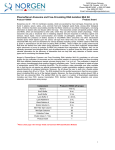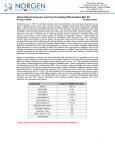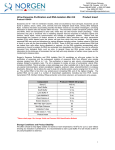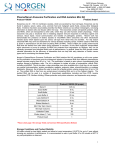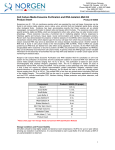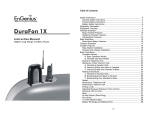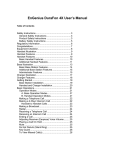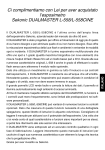Download (HMDA) website - National Consumer Law Center
Transcript
March 6, 2014 Ren Essene Senior Policy Analyst, Team Lead, Mortgage Data Assets Consumer Financial Protection Bureau 1700 G Street NW Washington DC 20006 Dear Ms. Essene: The Consumer Financial Protection Bureau’s recent launch of the expanded Home Mortgage Disclosure Act (HMDA) website represents a leap forward in making HMDA data accessible to community groups and the public. The site includes important new features, such as data filtering and summary tables, that will enhance the public’s, regulators’ and policy makers’ ability to hold mortgage lenders accountable, identify instances in which investigations and enforcement actions are warranted, and help identify communities in need of targeted investments. The CFPB has succeeded in making HMDA data more accessible to the public, especially to community groups that do not have the resources to undertake significant data analysis but care deeply about mortgage lending in their neighborhoods. There are some aspects of the new website, however, that are confusing or difficult to work with, and the CFPB should take quick corrective action to ensure that users can generate accurate, useable data and summary tables with the new website. The CFPB Should Create a User Guide for the New Website Although the site makes many selections, exports, and summaries of HMDA data more convenient, there are significant issues that limit the potential of the site as a support for new and less data-savvy users of HMDA data. The site design assumes that users have vastly different levels of understanding and skills in different sections of the site. The video introduction and transcript, for example, are targeted to users with almost no knowledge or understanding of the mortgage loan origination process. The filtering and summary table programs, on the other hand, may seem to be designed for novice users from the point of view of the experienced programmers who built them, but they assume quite a bit of understanding about both the mortgage data and the use of the filtering and summary table menus and drop-downs. The little “?” buttons are not a sound replacement for a real manual and set of examples of the data and how they might be used. The CFPB should make the following downloadable documents available: 1. A user manual with examples or tutorials to explain and illustrate how to navigate and use the filtering and summary table programs. This manual needs to be written for beginners, but with a PDF table of contents format that allows more experienced users to skip to the sections that cover particular issues. The issues in the manual should include the full definition of each field, definitions of the census fields in the excel files, examples of how fields are used, and explanations of the field layout that users can expect from the exported spreadsheets; 2. An alphabetical list in .csv format of the lenders active in each MSA (created by the CFPB from the raw HMDA data) including the Lender ID used in the HMDA data, the parent company, the reporting agency and code, and at least the total number of applications and loans in the MSA so that the largest lenders can be sorted and identified and so that the list can be used easily to identify the Lender ID for particular lenders and lenders under the same parent company; 3. At least a link to the FHA and GSE tables for loan limits by year so that lending within these programs can be compared to comparable or other lending patterns; and, 4. A fleshed-out explanation of the contents of the links to the FFIEC site, the section of the CFPB examination manual on HMDA, the FFIEC book on reporting the HMDA data, etc. Overall, the tool is a huge improvement and makes HMDA much more accessible to the public. When the CFPB adds clear, straightforward documentation, the tool will help grassroots organizations access HMDA in a meaningful way. Filtering Data The site’s built-in filters for HMDA data are very useful, but the filtering options can be confusing and should be made more user-friendly. The site design hides many important filter options, starting with the fact that users do not find out that they can create custom data filters until after a pre-set filter is selected. The initial filter drop down menu should include an additional option for a user-defined, custom filter. This hidden filter problem is pervasive throughout the site. For example, it is not obvious that selecting a state geographic filter will then allow users to select counties and census tracts. The main location filter menu should immediately show all three filters for state, county and census tract when users click on the “Location” filter. All filters should show all available levels of filtering without requiring users to make a selection first. Lender Searches The lender search feature of the new HMDA site is difficult to use and yields results that will mislead newer HMDA users and substantially impair community groups’ and the public’s ability to analyze mortgage lending patterns in their neighborhoods, particularly for large bank holding companies. The lender search will also cause significant data quality problems if lenders change respondent ID numbers, as Citibank did in 2011, unless the CFPB updates the search function to allow searches by parent company. The CFPB should develop an accurate lender search tool that will allow users to search for all loans made by individual HMDA-reporting lenders as well as for all loans made by parent companies that make loans using subsidiary and affiliated companies. As an interim step, the CFPB should improve the existing lender search interface to make clear to users that lender searches will not necessarily return all loans made by a given lender and its subsidiaries, affiliates or parent company. The CFPB should also provide clearer instructions on how to use the lender ID number provided by the FFIEC website Create a Complete Lender Search Tool The CFPB should prioritize building a complete lender search tool that will allow users to search for HMDA-reporting lenders individually as well as for all loans reported by subsidiaries and affiliates of large bank holding companies. The lender search should allow searches by lender name, include a drop-down menu of commonly searched-for lenders, and should allow users to select whether to search for only the HMDA-reporting lender’s loans or for all loans made by that lender, its parent company, and any subsidiaries or affiliates of the lender or its parent company. This type of search would be relatively simple to implement if the CFPB included Reporter Panel data in its HMDA site. Consider Wells Fargo, as one example of many. Wells Fargo makes and reports mortgage loans not only as Wells Fargo Bank and Wells Fargo Funding (for loans made in 2011 and prior), but also as the parent company of subsidiary and affiliated lenders, DE Capital Mortgage, First Allied Home Mortgage and Thoroughbred Mortgage, among others. These companies do not appear in a keyword search for loans made by Wells Fargo on the FFIEC lender search website. HMDA database users interested in Wells Fargo’s lending would have to possess in-depth knowledge of the mortgage market or of the company to know to search for both Wells Fargo Bank and Wells Fargo Funding, not to mention the bank’s subsidiaries and affiliates. Improve the Existing Lender Search Tool While the complete lender search tool is in development, the CFPB should take quick action to improve the existing tool. The CFPB should add a warning to the existing lender search tool that conducting a lender search by name in the FFIEC’s institution search will not necessarily include all loans made by bank holding companies and other lenders that make loans through subsidiaries and affiliates. The warning should include a link to the Reporter Panel data that are made public on the FFIEC website and should provide a link to instructions on how to use the Reporter Panel data to identify subsidiaries, affiliates and parent companies. The lender search interface is also confusing for users—even experienced HMDA users—as it is currently structured. The search function relies on the FFIEC’s institution search by bank name, but that site does not clearly indicate which federal agency users should select when searching by lender ID number. Very few HMDA users will know which federal agency to select when searching for a particular lender and new users will likely not have the expertise to find that information on their own. The search interface should include a link that explains how to determine to which federal agency a lender reports HMDA data. In addition, the CFPB’s site does not make use of the full lender ID number provided by the FFIEC website. The site’s automatic truncation of a pasted lender ID number is helpful, but any users attempting to type in an ID number will not know that the first 10 digits of the number are needed but the suffix with two additional numbers is not. Further complicating matters, the ID numbers for independent mortgage companies in the FFIEC data are actually the federal tax ID number, which includes a hyphen. The CFPB site will not accept the code unless the hyphen is deleted. A note indicating that only the first 10 digits of the FFIEC’s lender ID are needed would help users feel more confident in their ability to search by lender. Finally, the data output generated by a lender search must include the lender name in addition to the lender ID number. The lender search is the most confusing aspect of the new HMDA site, and adding lender names would be an easy way to reassure users that they received the data output they expected. Census Data Although the census tract-level data for each loan application are included in the data output, they are not included in the filtering process or in the list of variables available in the summary tables. The inclusion of surprise census data in the downloaded tables is not problematic, but the CFPB could make the HMDA site much more effective by integrating census data into the filters and summary table options. The CFPB’s omission of census data from filters and summary tables means that the public cannot use the site to review lending by census tract characteristics including ethnicity, race, or income as is possible using several of the FFIEC tables. The CFPB should add census data to the filters, and allow users to select data filtered by popular categories of census data. For example, the site should allow users to download data or produce a summary table that includes only information for low income (or moderate, middle or upper income) census tracts, or for tracts that are majority non-white versus majority white. Many of the census data fields are reported as percentages, but are not labeled as percentages in the data output. The HMDA site documentation and data downloads should indicate the data type for all fields. It would also be helpful for more experienced HMDA users if the data output included the 11 digit FIPS code that signifies state, county and census tract. Users would then be able to transfer the data output directly into GIS mapping software. MSAs The CFPB should improve the “Location” filter by providing a list of counties within a selected MSA and allowing users to choose a subset of those counties from within the MSA search— following the lead of the existing FFIEC application. Downloading filtered data for large MSAs is also sometimes problematic – for example, a modified selection for Chicago, which is large, caused the site to hang and download only 92 of the 445 KBs of data. Eventually, about a third of the records downloaded. So, the site may not be powerful enough to allow users to download the full or partly screened HMDA data for an MSA even if users are working from powerful desk computers and not mobile devices. Saving Filtered Data The site’s feature allowing users to save filters and summary tables and to share them via a unique link is a great way to encourage groups to share their analyses and results. It is a cumbersome way to save work for individual users, however, and the CFPB should add an option to save the links to filters and summary tables in user accounts. Exporting Data Also, the field order of the variables from the exported data places the census tract numbers first and then has no particular order for the remaining variables. Because some loans lack a code for the tract, the blank in the first column creates a problem when trying to block and copy the data (as the block may end at the first blank tract rather than at the last row of data). Many key fields are separated from each other and interspersed among other unrelated fields, such as state code, county code, and MSA code. Race and ethnicity data for applicants and co-applicants are separated from each other, and the co-applicant data are placed before the applicant data. The order used in the FFIEC export program places the fields in the order of the raw HMDA data that matches the field order for the FFIEC code explanations. This order is both more familiar for existing users and keeps related fields together in a fairly logical order. Summary Tables The summary table feature of the HMDA site offers HMDA users a convenient way to do basic HMDA analyses, and will allow new users to explore the data in much more depth than the FFIEC tables allowed. The CFPB should improve this tool further by adding rate spread data, a lender comparison feature, and row and column sum and percentage data. The CFPB should add rate spread to the summary table feature as both a variable, summarized as a categorical variable indicating whether or not a rate spread was reported, and as an option in the “number of records” drop-down menu, summarizing the raw rate spread data. The CFPB should also add a lender comparison feature to the summary tables. Users should be able to select multiple lenders in summary tables to compare lenders side by side – users might want to do a quick analysis of three of Boston's top bank lenders, for example, and having a summary table that could show results for Bank of America, Citizens and Sovereign in the same table would be very helpful. The summary tables are missing a total row and column sum or percentage feature. If Bank of America made 97 home purchase loans to black borrowers in Massachusetts in 2012, for example, it would be helpful to see the percentage of loans made to black borrowers over all loans Bank of America made in 2012 automatically, without having to manually calculate that 97 loans represented only 9.6% of the bank’s total home purchase lending in Massachusetts in 2012. In addition, when users summarized data from multiple years, the table sometimes showed the total number of loans for 2010-12 as opposed to showing the count for each year, which would enable users to quickly see if lending was going up or down over that time period. The summary tables should allow users to choose whether to display row or column sums and/or percentages, and should display data for each year, lender, or other grouping variable as well. FFIEC & CFPB Data Sites The CFPB program is essentially an easier to use, interactive version of the FFIEC’s existing HMDA software. The filtering program is the very similar to the FFIEC HMDA software program except that it replaces the codes with names (except for lenders). There is an option in the CFPB program to download the table with both the data names AND the codes, which is helpful for new users, though this makes the tables much larger and may lock up the program when the files are large. One advantage over the FFIEC software is that on the CFPB site users can select multiple MSAs, counties, states, lenders, and census tracts. Users have to select each individual tract separately rather than in a block (e.g. tracts 101:150), which means that in areas of any size the selection process becomes quite cumbersome. A link to census tract maps would also make it easier for local groups to use this function since people do not typically know which census tracts cover their neighborhoods or communities. Despite the new features offered by the CFPB’s HMDA site, converting the existing FFIEC lender and aggregate MSA data tables to Excel formats would be valuable in that some of these tables will rapidly produce some commonly used data by both applicant race and income (as well as the race and income of census tracts). The CFPB should not abandon the effort to review the existing tables, to delete those with little use or limited value and to add new tables based on a survey of common needs. Notwithstanding the added value of the CFPB filtering and summary table resources, it may still be easier in the end in many cases to use Excel versions of the FFIEC pre-formatted tables (especially if the existing tables are reviewed and updated) rather than trying to work through the filtering and summary table programs on the CFPB site each time users want to quickly review data for an MSA or lender. Even if the FFIEC tables are not revised, the CFPB could easily develop macros to convert the existing txt version of the FFIEC tables to excel files on its own HMDA site and make available templates that would add percentage calculations to the numerical data in the FFIEC tables. These macros and templates could be activated on the site or downloadable for users to apply. Indeed, adding simple percentage distribution data to these FFIEC tables might be the easiest way to involve more individuals and groups in using HMDA data. Technology Problems The site’s tendency to freeze up or time out users is likely to make new potential users reluctant to explore the site. The CFPB should also separate more clearly the parts of the site designed for web designers and developers so that the casual visitor to the site does not mistakenly click onto these pages and get scared off. Conclusion The CFPB’s new HMDA site is an exciting new tool that has the potential to expand the public’s use of HMDA data signficiantly. We urge the CFPB to adopt the proposals we suggest in this letter to ensure that community and neighborhood groups will have the clear documentation, functionality and informative summary tables needed to make full use of HMDA data. Please contact the undersigned organizations with any questions about this letter. Respectfully, Americans for Financial Reform Association for Neighborhood and Housing Development (ANHD) California Reinvestment Coalition Consumer Action Empire Justice Center Massachusetts Affordable Housing Alliance National Community Reinvestment Coalition National Consumer Law Center (on behalf of its low-income clients) National Fair Housing Alliance National People’s Action New Economy Project Ohio Fair Lending Coalition Reinvestment Partners Woodstock Institute








